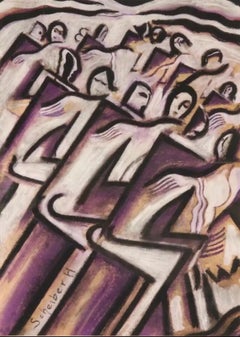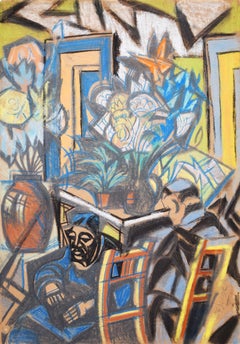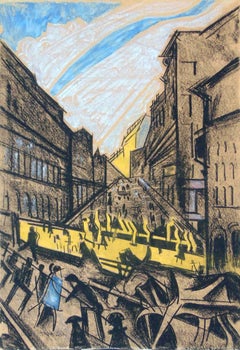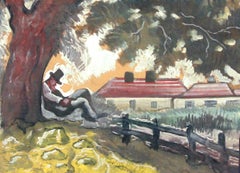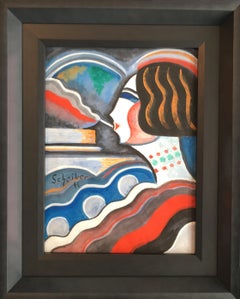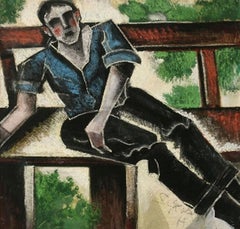Hugó Scheiber Drawings and Watercolor Paintings
to
1
2
1
1
Overall Width
to
Overall Height
to
5
2
1
1
1
4
1
4
2
2
1
1
1
1
1
1
1
1
1
3
3
3
3
3
10
971
401
359
279
1
3
2
Artist: Hugó Scheiber
Rare Modernist Hungarian Rabbi Pastel Drawing Gouache Painting Judaica Art Deco
By Hugó Scheiber
Located in Surfside, FL
Rabbi in the synagogue at prayer wearing tallit and tefillin.
Hugó Scheiber (born 29 September 1873 in Budapest – died there 7 March 1950) was a Hungarian modernist painter.
Hugo Scheiber was brought from Budapest to Vienna at the age of eight where his father worked as a sign painter for the Prater Theater. At fifteen, he returned with his family to Budapest and began working during the day to help support them and attending painting classes at the School of Design in the evening, where Henrik Papp was one of his teachers. He completed his studies in 1900. His work was at first in a post-Impressionistic style but from 1910 onward showed his increasing interest in German Expressionism and Futurism. This made it of little interest to the conservative Hungarian art establishment.
However, in 1915 he met the great Italian avant-gardist Filippo Tommaso Marinetti and the two painters became close friends. Marinetti invited him to join the Futurist Movement. The uniquely modernist style that he developed was, however, closer to German Expressionism than to Futurism and eventually drifted toward an international art deco manner similar to Erté's. In 1919, he and his friend Béla Kádar held an exhibition at the Hevesy Salon in Vienna. It was a great success and at last caused the Budapest Art Museum to acquire some of Scheiber's drawings. Encouraged, Scheiber came back to live in Vienna in 1920.
A turning point in Scheiber's career came a year later, when Herwarth Walden, founder of Germany's leading avant-garde periodical, Der Sturm, and of the Sturm Gallery in Berlin, became interested in Scheiber's work. Scheiber moved to Berlin in 1922, and his paintings soon appeared regularly in Walden's magazine and elsewhere. Exhibitions of his work followed in London, Rome, La Paz, and New York.
Scheiber's move to Germany coincided with a significant exodus of Hungarian artists to Berlin, including Laszlo Moholy-Nagy and Sandor Bortnyik. There had been a major split in ideology among the Hungarian avant-garde. The Constructivist and leader of the Hungarian avantgarde, Lajos Kassák (painted by Hugó Scheiber in 1930) believed that art should relate to all the needs of contemporary humankind. Thus he refused to compromise the purity of his style to reflect the demands of either the ruling class or socialists and communists. The other camp believed that an artist should be a figurehead for social and political change.
The fall out and factions that resulted from this politicisation resulted in most of the Hungarian avant gardists leaving Vienna for Berlin. Hungarian émigrés made up one of the largest minority groups in the German capital and the influx of their painters had a significant effect on Hungarian and international art. Another turning point of Scheiber's career came in 1926, with the New York exhibition of the Société Anonyme, organized by Katherine Dreier. Scheiber and other important avant garde artists from more than twenty-three countries were represented. In 1933, Scheiber was invited by Marinetti to participate in the great meeting of the Futurists held in Rome in late April 1933, Mostra Nazionale d’Arte Futurista where he was received with great enthusiasm. Gradually, the Hungarian artists began to return home, particularly with the rise of Nazism in Germany. Kádar went back from Berlin in about 1932 and Scheiber followed in 1934.
He was then at the peak of his powers and had a special flair in depicting café and cabaret life in vivid colors, sturdily abstracted forms and spontaneous brush strokes. Scheiber depicted cosmopolitan modern life using stylized shapes and expressive colors. His preferred subjects were cabaret and street scenes, jazz musicians, flappers, and a series of self-portraits (usually with a cigar). his principal media being gouache and oil. He was a member of the prestigious New Society of Artists (KUT—Képzőművészek Új Társasága)and seems to have weathered Hungary's post–World War II transition to state-communism without difficulty. He continued to be well regarded, eventually even receiving the posthumous honor of having one of his images used for a Russian Soviet postage stamp (see image above). Hugó Scheiber died in Budapest in 1950.
Paintings by Hugó Scheiber form part of permanent museum collections in Budapest (Hungarian National Museum), Pecs (Jannus Pannonius Museum), Vienna, New York, Bern and elsewhere. His work has also been shown in many important exhibitions, including:
"The Nell Walden Collection," Kunsthaus Zürich (1945)
"Collection of the Société Anonyme," Yale University Art Gallery, New Haven, Connecticut (1950)
"Hugó Scheiber: A Commemorative Exhibition," Hungarian National Museum, Budapest (1964)
"Ungarische Avantgarde," Galleria del Levante, Munich (1971)
"Paris-Berlin 1900-1930," Centre Georges Pompidou, Paris (1978)
"L’Art en Hongrie, 1905-1920," Musée d’Art et l’Industrie, Saint-Etienne (1980)
"Ungarische Avantgarde in der Weimarer Republik," Marburg (1986)
"Modernizmus," Eresz & Maklary Gallery, Budapest (2006)
"Hugó Scheiber & Béla Kádár," Galerie le Minotaure, Paris and Tel Aviv (2007)
Hugó Scheiber's paintings continue to be regularly sold at Sotheby's, Christie's, Gillen's Arts (London), Papillon Gallery (Los Angeles) and other auction houses.
He was included in the exhibition The Art Of Modern Hungary 1931 and other exhibitions along with Vilmos Novak Aba, Count Julius Batthyany, Pal Bor, Bela Buky, Denes Csanky, Istvan Csok, Bela Czobel, Peter Di Gabor, Bela Ivanyi Grunwald, Baron Ferenc Hatvany, Lipot Herman, Odon Marffy, C. Pal Molnar...
Category
Early 20th Century Modern Hugó Scheiber Drawings and Watercolor Paintings
Materials
Paper, Charcoal, Pastel, Watercolor, Gouache
Deco Dancing Hungarian Expressionism European Drawing Modernism Figurative Dance
By Hugó Scheiber
Located in New York, NY
Deco Dancing Hungarian Expressionism European Drawing Modernism Figurative Dance. 22 1/2 x 16 inches. Signed lower left. Framed.
BIO
Hugó Scheiber was born in Budapest in 1873. At the age of eight, he moved with his family from Budapest to Vienna.
In 1898, to help support his family after they had returned to Budapest. He started working during the day, attending painting classes at the Commercial Art School in the evening. In 1900, he completed his studies.
Scheiber showed an early interest in German Expressionism and Futurism. In 1915 he met Marinetti, who invited him to join the Futurist movement. Because Scheiber's paintings conflicted with academic style of the Hungarian art establishment, his work was virtually ignored in his own country. In 1919, he and his friend Béla Kádár held an exhibition organized by Hévesy in Vienna, which was a great success, so much so that the Budapest Art Museum purchased two of his drawings.
In 1920, Scheiber returned to Vienna. A turning point in his career came in 1921 when Herwarth Walden, founder of Germany's leading avant-garde periodical, Der Sturm...
Category
1920s Art Deco Hugó Scheiber Drawings and Watercolor Paintings
Materials
Paper, Gouache
Couple at the Table with Flowers - Hungarian Futurism Cubism 1930s Figurative
By Hugó Scheiber
Located in London, GB
This original pastel drawing is hand signed by the artist "Scheiber H" in the lower right image.
This work was created circa 1930-1940.
Provenance: Estate of the artist.
David Gilad...
Category
1930s Cubist Hugó Scheiber Drawings and Watercolor Paintings
Materials
Paper, Pastel
The Rhythm of the City - Hungarian Art Futurism Cubism
By Hugó Scheiber
Located in London, GB
HUGO SCHEIBER 1873-1950
1873 - Budapest - 1950 (Hungarian)
Title: The Rhythm of the City, 1920's/1930's
Technique: Original Signed Charcoal and Pastel Drawing on Paper
Size: 61 x ...
Category
1920s Cubist Hugó Scheiber Drawings and Watercolor Paintings
Materials
Charcoal, Pastel
The Rest
By Hugó Scheiber
Located in London, GB
HUGO SCHEIBER 1873-1950
1873 - Budapest - 1950 (Hungarian)
Title: The Rest
Technique: Signed Gouache Painting on Brown Paper
Size: 35.5 x 49 cm. / 14.8 x 1...
Category
20th Century Hugó Scheiber Drawings and Watercolor Paintings
Materials
Gouache
$5,800
Related Items
Marguerite - 19th Century Pre-Raphaelite Painting of Beauty from Goethe's Faust
By Henry Meynell Rheam
Located in Gerrards Cross, GB
‘Marguerite’ by Henry Meynell Rheam RI (1859-1920). The painting is signed with monogram and dated. Watercolour and gouache on paper, newly remounted, glazed with non-reflective UV r...
Category
Late 19th Century Pre-Raphaelite Hugó Scheiber Drawings and Watercolor Paintings
Materials
Watercolor, Gouache
$8,115
H 24 in W 22 in D 3 in
"Masha's fairy tales" watercolor cm. 17 x 22 1970
By Marina Yevgenyevna Uspenskaya
Located in Torino, IT
Children, illustrations, tales
Marina Evgenevna USPENSKAYA (Moscow, 1925 – 2007)
Marina Evgenevna Uspenskaya was born in Moscow. She graduated from the 1905 Art College, where she ...
Category
1970s Realist Hugó Scheiber Drawings and Watercolor Paintings
Materials
Paper, Watercolor
$1,792 Sale Price
25% Off
H 14.97 in W 13 in
Firefight
By William Thomas Smedley
Located in Fredericksburg, VA
"Firefighting" is a dramatic monotone watercolor painting by William Thomas Smedley, depicting the intense efforts of firefighters battling a high-rise building fire. The unique L-shaped composition draws the viewer's eye from the scene of action below to the perilous situation above.
At the base of the painting, firefighters are shown bravely combating the flames, with water hoses...
Category
Late 19th Century Hugó Scheiber Drawings and Watercolor Paintings
Materials
Paper, Watercolor
A Dynamic 1945 Mid-Century Modern Cubist Studio Scene, Artist Sketch Class
By Harold Haydon
Located in Chicago, IL
A Dynamic, 1945 Mid-Century Modern Cubist Studio Scene, Artist's Sketch Class by Noted Chicago Painter, Harold Haydon (Am. 1909-1994). Artwork size: 11 x 8 1/2 inches, unframed, mo...
Category
Mid-20th Century Cubist Hugó Scheiber Drawings and Watercolor Paintings
Materials
Paper, Charcoal, Pastel
$385
H 15 in W 12 in D 0.13 in
Demonstration #1 Hélène Duclos, 21st Century, Contemporary figurative art blue
By Hélène Duclos
Located in Paris, FR
Gouache, coloured pencil and graphite on paper
Signed lower right
Unique work
1 / Hélène DUCLOS, 2016 – Artist Statement
“Questioning the human condition and the position of being ...
Category
21st Century and Contemporary Contemporary Hugó Scheiber Drawings and Watercolor Paintings
Materials
Paper, Gouache
$5,019
H 25.99 in W 40.16 in D 1.97 in
Jean Marais, Cocteau's Muse, Master of Stage Design: Curtain for Sleeping Beauty
By Jean Marais
Located in Norwich, GB
Jean Marais (1913–1998) is immortalised as the face of French cinema's golden age—the hero of Beauty and the Beast, the swashbuckler of Le Bossu, and the muse of Jean Cocteau. Yet, t...
Category
Mid-20th Century French School Hugó Scheiber Drawings and Watercolor Paintings
Materials
Paper, Gouache
Jean MaraisJean Marais, Cocteau's Muse, Master of Stage Design: Curtain for Sleeping Beauty, ca 1950
$2,400
H 14.38 in W 18.71 in D 0.4 in
'Study for a Stained Glass Window', Devotional, Ecclesiastical, Pre-Raphaelite
Located in Santa Cruz, CA
A sensitively drawn and highly-detailed study for a three-panel set of stained glass windows showing the ascension of Jesus by angels and mortals.
Initialed, lower right, 'EB-J', an...
Category
1920s Academic Hugó Scheiber Drawings and Watercolor Paintings
Materials
Ink, Watercolor, Gouache
Neoclassical composition of a sculptor kneeling before his statue of the Madonna
Located in Middletown, NY
An allegory of loyalty, with the subject's dog pictured seated, holding his master's chisel in his mouth; fidelity personified.
Italian School, 18th century
Ink wash in gray and bl...
Category
Mid-18th Century Italian School Hugó Scheiber Drawings and Watercolor Paintings
Materials
Laid Paper, Ink, Watercolor
$500
H 9.73 in W 7.01 in
'Mending', African American Woman Folk Artist, Houston, Dallas, Blues Museum Oil
Located in Santa Cruz, CA
Signed lower center, in fabrics bowl, 'Ruth Mae McCrane' (American, 1929-2002) and dated upper center, in calendar, February 1989.
Ruth Mae McCrane taught...
Category
1980s Folk Art Hugó Scheiber Drawings and Watercolor Paintings
Materials
Paper, Gouache
1950s Vintage Charcoal Female Nude Study by Henry Woon
Located in Arp, TX
Henry Woon
Charcoal Female Nude 2
c. 1950's
Charcoal on Strathmore Charcoal Paper
25"x19 1/2"Unframed
Signed in ink H Woon lower right
His large portfolio of charcoal drawings was ...
Category
1950s Cubist Hugó Scheiber Drawings and Watercolor Paintings
Materials
Paper, Charcoal
1929 "Nude with Cubist Sculpture" Charcoal Female Nude Drawing UCBerkeley Artist
Located in Arp, TX
John Bowers Collection
Nude With Cubist Sculpture
1929
Charcoal on Paper
18.75"x24.75", unframed
Dated in charcoal lower right
Came from a portfolio owned by artist John Bowers
John was awarded a Master of Fine Arts degree by the University of California, at Berkeley.
His collection included pieces by fellow student artists and professors at UC Berkeley including Fred Reichman...
Category
Early 20th Century Cubist Hugó Scheiber Drawings and Watercolor Paintings
Materials
Paper, Charcoal
$1,080 Sale Price
40% Off
H 24.75 in W 18.75 in
A Colorful, Panoramic Mid-Century Modern View of Nazaré, Portugal by Rudolph Pen
Located in Chicago, IL
A Colorful, Panoramic Mid-Century Modern View of the famed fishing village (and renowned surfing locale) of Nazaré, Portugal by Rudolph Pen. Painted in the 1960s, this vivid waterco...
Category
Mid-20th Century American Modern Hugó Scheiber Drawings and Watercolor Paintings
Materials
Paper, Charcoal, Pastel, Watercolor
$750
H 12.5 in W 25.5 in D 0.13 in
Previously Available Items
Untitled image of woman smoking by modernist painter Hugó Scheiber
By Hugó Scheiber
Located in Hudson, NY
This artwork is framed with non-reflective, UV protection Museum glass. The frame size is 15.5" x 12.75"
About this artist: Hugó Scheiber was born in Budapest, Hungary in 1873. His ...
Category
Early 20th Century Modern Hugó Scheiber Drawings and Watercolor Paintings
Materials
Paper, Tempera, Gouache
"Man on a Bench" Hungarian Futurist, Expressionist, Figurative Portrait Modern
By Hugó Scheiber
Located in New York, NY
"Man on a Bench" Hungarian Futurist, Expressionist, Figurative Portrait Modern. Signed lower right
Scheiber is considered one of Hungary’s great modernists.
Scheiber showed an earl...
Category
1920s Modern Hugó Scheiber Drawings and Watercolor Paintings
Materials
Paper, Mixed Media
Rare Modernist Hungarian Rabbi Pastel Drawing Gouache Painting Judaica Art Deco
By Hugó Scheiber
Located in Surfside, FL
Rabbi in the synagogue at prayer wearing tallit and tefillin.
Hugó Scheiber (born 29 September 1873 in Budapest – died there 7 March 1950) was a Hungarian modernist painter.
Hugo Scheiber was brought from Budapest to Vienna at the age of eight where his father worked as a sign painter for the Prater Theater. At fifteen, he returned with his family to Budapest and began working during the day to help support them and attending painting classes at the School of Design in the evening, where Henrik Papp was one of his teachers. He completed his studies in 1900. His work was at first in a post-Impressionistic style but from 1910 onward showed his increasing interest in German Expressionism and Futurism. This made it of little interest to the conservative Hungarian art establishment.
However, in 1915 he met the great Italian avant-gardist Filippo Tommaso Marinetti and the two painters became close friends. Marinetti invited him to join the Futurist Movement. The uniquely modernist style that he developed was, however, closer to German Expressionism than to Futurism and eventually drifted toward an international art deco manner similar to Erté's. In 1919, he and his friend Béla Kádar held an exhibition at the Hevesy Salon in Vienna. It was a great success and at last caused the Budapest Art Museum to acquire some of Scheiber's drawings. Encouraged, Scheiber came back to live in Vienna in 1920.
A turning point in Scheiber's career came a year later, when Herwarth Walden, founder of Germany's leading avant-garde periodical, Der Sturm, and of the Sturm Gallery in Berlin, became interested in Scheiber's work. Scheiber moved to Berlin in 1922, and his paintings soon appeared regularly in Walden's magazine and elsewhere. Exhibitions of his work followed in London, Rome, La Paz, and New York.
Scheiber's move to Germany coincided with a significant exodus of Hungarian artists to Berlin, including Laszlo Moholy-Nagy and Sandor Bortnyik. There had been a major split in ideology among the Hungarian avant-garde. The Constructivist and leader of the Hungarian avantgarde, Lajos Kassák (painted by Hugó Scheiber in 1930) believed that art should relate to all the needs of contemporary humankind. Thus he refused to compromise the purity of his style to reflect the demands of either the ruling class or socialists and communists. The other camp believed that an artist should be a figurehead for social and political change.
The fall out and factions that resulted from this politicisation resulted in most of the Hungarian avant gardists leaving Vienna for Berlin. Hungarian émigrés made up one of the largest minority groups in the German capital and the influx of their painters had a significant effect on Hungarian and international art. Another turning point of Scheiber's career came in 1926, with the New York exhibition of the Société Anonyme, organized by Katherine Dreier. Scheiber and other important avant garde artists from more than twenty-three countries were represented. In 1933, Scheiber was invited by Marinetti to participate in the great meeting of the Futurists held in Rome in late April 1933, Mostra Nazionale d’Arte Futurista where he was received with great enthusiasm. Gradually, the Hungarian artists began to return home, particularly with the rise of Nazism in Germany. Kádar went back from Berlin in about 1932 and Scheiber followed in 1934.
He was then at the peak of his powers and had a special flair in depicting café and cabaret life in vivid colors, sturdily abstracted forms and spontaneous brush strokes. Scheiber depicted cosmopolitan modern life using stylized shapes and expressive colors. His preferred subjects were cabaret and street scenes, jazz musicians, flappers, and a series of self-portraits (usually with a cigar). his principal media being gouache and oil. He was a member of the prestigious New Society of Artists (KUT—Képzőművészek Új Társasága)and seems to have weathered Hungary's post–World War II transition to state-communism without difficulty. He continued to be well regarded, eventually even receiving the posthumous honor of having one of his images used for a Russian Soviet postage stamp (see image above). Hugó Scheiber died in Budapest in 1950.
Paintings by Hugó Scheiber form part of permanent museum collections in Budapest (Hungarian National Museum), Pecs (Jannus Pannonius Museum), Vienna, New York, Bern and elsewhere. His work has also been shown in many important exhibitions, including:
"The Nell Walden Collection," Kunsthaus Zürich (1945)
"Collection of the Société Anonyme," Yale University Art Gallery, New Haven, Connecticut (1950)
"Hugó Scheiber: A Commemorative Exhibition," Hungarian National Museum, Budapest (1964)
"Ungarische Avantgarde," Galleria del Levante, Munich (1971)
"Paris-Berlin 1900-1930," Centre Georges Pompidou, Paris (1978)
"L’Art en Hongrie, 1905-1920," Musée d’Art et l’Industrie, Saint-Etienne (1980)
"Ungarische Avantgarde in der Weimarer Republik," Marburg (1986)
"Modernizmus," Eresz & Maklary Gallery, Budapest (2006)
"Hugó Scheiber & Béla Kádár," Galerie le Minotaure, Paris and Tel Aviv (2007)
Hugó Scheiber's paintings continue to be regularly sold at Sotheby's, Christie's, Gillen's Arts (London), Papillon Gallery (Los Angeles) and other auction houses.
He was included in the exhibition The Art Of Modern Hungary 1931 and other exhibitions along with Vilmos Novak Aba, Count Julius Batthyany, Pal Bor, Bela Buky, Denes Csanky, Istvan Csok, Bela Czobel, Peter Di Gabor, Bela Ivanyi Grunwald, Baron Ferenc Hatvany, Lipot Herman, Odon Marffy, C. Pal Molnar...
Category
Early 20th Century Modern Hugó Scheiber Drawings and Watercolor Paintings
Materials
Paper, Pastel, Watercolor, Gouache, Charcoal
Hugó Scheiber drawings and watercolor paintings for sale on 1stDibs.
Find a wide variety of authentic Hugó Scheiber drawings and watercolor paintings available for sale on 1stDibs. You can also browse by medium to find art by Hugó Scheiber in gouache, paint, watercolor and more. Much of the original work by this artist or collective was created during the 20th century and is mostly associated with the modern style. Not every interior allows for large Hugó Scheiber drawings and watercolor paintings, so small editions measuring 8 inches across are available. Customers who are interested in this artist might also find the work of Aristide Maillol, Jacques Villon, and Winold Reiss. Hugó Scheiber drawings and watercolor paintings prices can differ depending upon medium, time period and other attributes. On 1stDibs, the price for these items starts at $5,500 and tops out at $26,000, while the average work can sell for $7,250.
Artists Similar to Hugó Scheiber
Lucien-Victor Guirand de Scévola

